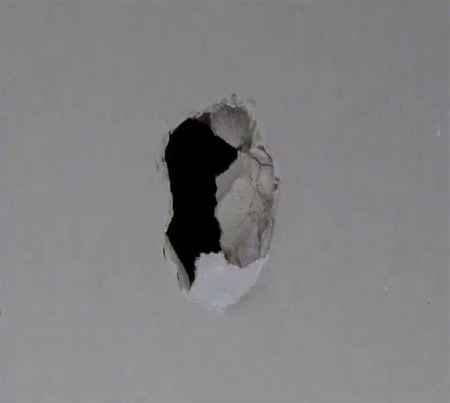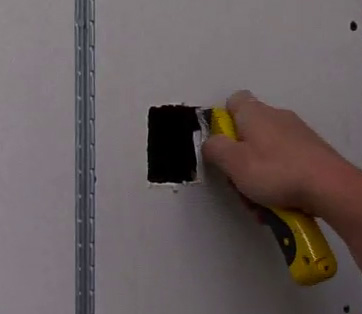Due to the nature of plasterboard and in a similar way hollow doors, they can become damaged quite easily.
Plasterboard is quite soft and the slightest of impacts such as when moving furniture can mark the surface and even put a hole right through it. The same can also be said for hollow doors – Due to the void in the centre and MDF or fibreboard used as the covering, this does not provide much protection when it comes to resisting impacts.
Another complication that springs to light when you have unfortunately made a hole in a plasterboard wall or hollow door is the void behind it due to the construction of the stud work used to hold the plasterboard up or provide the framework for the door meaning that you can’t just use filler as there is nothing to bond it to.
Fortunately there are a few tricks you can use in order to successfully fill a hole of this type, whether it is in a plasterboard wall or a hollow door. Additionally, if you take your time over the repair and filling stage then there is no reason why the repair shouldn’t be very hard to spot.

Repairing hole in plasterboard
The two main repair methods can be found below:
Repairing a Plasterboard Hole Using a Piece of Plasterboard or Timber

Hole in plasterboard wall
Check for Wires, Pipes and Other Items
As you will need to do a bit of cutting, before you start this, firstly run over the area around the hole with a wire detector to make sure there aren’t any wires, pipes or other items that you may accidentally cut through.

Use a stud and wire detector to check the area surrounding the hole for electrical wires
Square the Hole up
To repair a hole in a hollow door, wall, or ceiling, firstly trim the edges of the hole and make is square. Ironically, you actually have to make the hole larger before you can go about fixing it!
Depending on the shape of the hole, whether its circular or has jagged edges you may need to use a padsaw, jabsaw or hobby knife. Be careful using any of these items as they are sharp and can slip quite easily.

Square up the hole using a padsaw or hobby knife
Cut a Repair Patch
Now that you have squared up the hole, the next job is to make a patch. You can either use a scrap piece of plasterboard or timber.
Hold your chosen patch material up to the base of the hole and mark its width. Once marked, measure and cut the patch to the correct width and then check that it passes through the hole nicely.

Making width of patch for the hole using a scrap piece of plasterboard
Now hold the patch to the side to mark its height but add an inch top and bottom. This is what you will use to stick the patch to the rear side of your wall. Once marked cut to the correct size.

Patch cut to width and height ready to be fitted
Push Screw into Centre
With the patch ready to go, the final job is to drill a small hole through the centre and push a screw through. The screw will be used to position and hold the patch in place until it dries. Once its dried and stuck in the hole you can push the screw out into the wall void.

Push a screw through the centre of the patch so that you can hold on to it
Add Adhesive
In order to ensure that the patch stays in place you will need to add some adhesive to the inch overlap that you left on the longest side of the patch and around the sides. In the image below we have used some patching plaster but you can use any heavy duty construction adhesive such as Grip Fill or No More Nails.

Add adhesive to the top, bottom and sides of the patch in order to hold it in place on the wall
Insert the Patch into the Hole
Pick up the patch by holding the screw and tilt it to insert it into the hole. Even it up so that you have a decent amount of overlap top and bottom so that the patch will be held firmly in place once the adhesive has set. Use gentle pulling pressure, while moving around slightly to ensure good contact between the adhesive and the back of the surface until you are sure the adhesive will hold the piece in place.
Depending on what adhesive you have used will depend on how long this is, check the manufacturers guidelines on drying time.
Once the adhesive has dried enough to support the patch you can now push the screw out into the wall void. Leave for a further 24 hours for the adhesive to completely harden off and then you can start filling.

Use the screw to hold the patch in place in the hole until the adhesive has dried
Fill in the Hole
The final stage to this repair is to fill the hole with a suitable filler such as Polyfilla or the like. Once mixed (or the tub is open if you have a pre-mixed version), scoop out a lump using a small trowel and apply it to the hole, using the trowel to completely fill the area of the hole by pushing into the corners.
Add as much filler as you need to until the hole is filled flush with the surface of the wall. Use the trowel to get the surface as flat as possible.

Plasterboard hole totally filled and leveled off
Repairing a Hole Using Timber Battens
Another way to fill a hole in plasterboard is to enlarge the hole first to make a square of a suitable size. Then cut two battens (19 x 38mm timber will suffice) and make sure they are 100mm longer than the size of the square you have cut.
Feed a batten into the hole and twist it so it is either upright or horizontal and one third of the distance either up or down or across the hole. Make sure you have a 50mm overhang either side of the hole.
With the batten positioned screw it in place through the front of the plasterboard making sure the screw heads go below the skim of plaster on the board. Do this with both battens and then cut a square of plasterboard to fit in the hole. This can be screwed to the battens with drywall screws and the square plastered together with the 4 screw holes for the battens.

Using battens to repair hole in plasterboard wall

